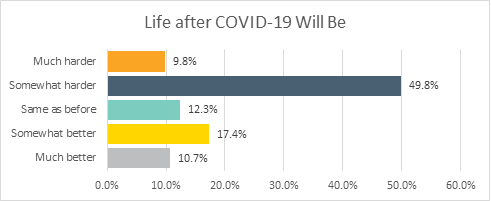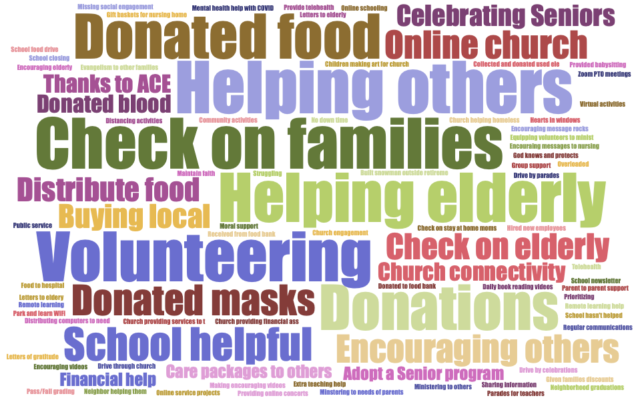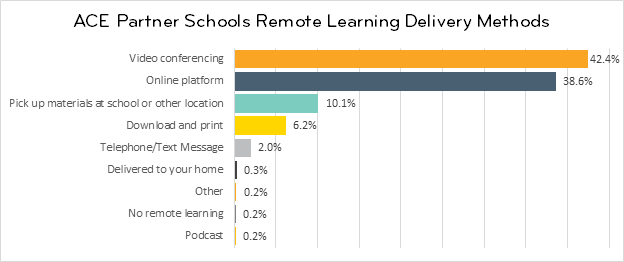ACE Scholarships (ACE) provides more than 7,000 scholarships to economically disadvantaged students attending more than 700 K-12 partner private schools in Arkansas, Colorado, Kansas, Louisiana, Missouri, Montana, Texas, and Wyoming. COVID-19 and the shutdown of schools and businesses have impacted these families and schools greatly. We surveyed all ACE families to get a better sense of how families are dealing with and how they are coping with this extraordinary crisis. The response rate was 26 percent or 1,313 families.
Key Findings:
A majority of families have been financially impacted by the loss of jobs, reduced hours, or the need to stay home due to their children’s school being shut down.

This impact will be long-lasting according to the families. They shared their concern that life is not going to return to normal anytime soon with almost 60 percent saying life after COVID-19 will be somewhat or much harder.

Economically disadvantaged families know the difficulties of living paycheck to paycheck. When their paycheck stops it hits them harder than most due to a lack of savings. This puts them further behind making a long road to recovery. ACE families, in particular, are acutely aware of the sacrifices they must make to have their child in a better and safer education environment. These financial sacrifices will be even harder due to the expected long-term nature and probability of the COVID-19 return this fall.
This pandemic has affected families’ physical and mental state. Using several oft-repeated keywords and phrases, shown in this word cloud below there is a general theme that is readily apparent. There is much anxiety, fear, and worry about the immediate future, families are using this time to build closer family bonds and help others.

These are a few of the example responses we received. (These survey responses have been altered for spelling and to ensure anonymity.)
- Family members have died from COVID-19. Not being able to be together & having to continue with school and work was surreal.
- No in-person church services. Parks are closed. Cannot see friends or be around people. This lifestyle is promoting isolationism.
- We only have one tablet for three kids to use for their classes. I haven’t worked since early March.
- The economic situation is dire; family situation stressful; and the learning experience is an adjustment.
- It has upended a lot of our plans as a family. My youngest can’t go to school. We can’t afford private school next year if this continues in the fall.
- We are gathering as a family every night for dinner and prayer which has been awesome. It’s been a challenge not being able to work, and the children not being able to go to school, but they have adapted well.
- We can’t afford to pay all our bills at this time due to getting furloughed. My child has increased anxiety and depression from the closure of schools and struggles without a teacher being present to help her.
- I am a small business owner and my business closed. I am not receiving any income currently. It’s been a little hard to get used to being on a school schedule, but we are trying to stay on top of it.
- My child is becoming depressed and not engaging.
- I healthcare worker caring directly for COVID-19 patients. My child must live with other family so as not to be exposed.
Schools, communities, and families themselves are finding ways to serve the neediest even with their own hardships. This is highlighted in the word cloud and example quotes below.

(These survey responses have been altered for spelling and to ensure anonymity.)
- I have been helping a group with an Adopt a Senior (gifting program for graduating seniors). I’ve been volunteering 10 to 14-hour days to help keep up on social media page to ensure seniors and sponsors are in contact so all seniors get a sponsor.
- We’ve been chalking positive things in people’s driveways and praying as a neighborhood community while practicing social distancing.
- School has reached out to see if we need anything, however they are struggling financially too.
- Several parents are serving other families in our school community allowing working parents to drop off their kids and go to work peacefully. Parents make and take food to families in need. We pray together. We use technology to share beautiful moments, like birthday parades, senior parade, and student packages.
- My second grader learned to sew and made over 200 masks to donate to nursing homes and cancer centers.
- We made signs of support for essential workers and put them on lawns of healthcare workers in our community.
- We helped some people worse off than us with food and money to solve their immediate needs. The school is helping the school community by giving us time to pay the tuition and re-registration fees.
- School provides grocery gift cards for needy families. My children have written notes to people in assisted living who aren’t able to have visitors along with writing thank you notes to health care workers.
- We gather at the end of every day and talk about news and new things happening, how we can help the way we have been helped…. pray for all of those in need and give thanks for what we had received. We love our life day by day, “God will provide.” We are very thankful for all you guys do for all of us in need.
Due to the school shutdowns, schools have unexpectedly had to find ways to facilitate distance learning. Nearly 75 percent of ACE partner schools deliver via online and video conference platforms. However, not all schools have relied on the internet for lessons and instruction. Some have allowed families to pick up hard-copy materials, and others have used calling or texting to get coursework to students.

While most families have been able to cope with a predominantly online approach to school, more than 12 percent of low-income ACE students have had to cope with substantial barriers that can inhibit their access to learning.

For the families that faced access barriers to online remote learning, the main issues are the lack of high-speed broadband internet or the lack of computer devices. Almost 36 percent of students lack access to a computer, tablet, or device needed for online learning. More than six in 10 students either do not have internet available in their area, cannot afford broadband internet service, or have slow internet and connectivity issues.
To review all the data, click here to review the full survey.
Individual state reports:
